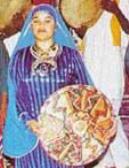About Baskets, Pots, and Jugs
Below you will find information on dancing with a basket, pot, or jug in bellydance.
Many North African, Middle Eastern, and South Western Asian cultures have traditions of carrying goods on their heads. Women learn as young girls the art of balancing a water jug full of water, a basket full of groceries, trays, pots, etc... on their heads. This keeps their hands free to carry other things, hold on to children, or just expressively emote their feelings in conversation through expressive hand gestures. Because this is considered a very common element of traditional life in these cultures it has worked it's way into both folkloric dances and "fakelore" as some dancers like to call it. Fakelore looks like a folk tradition but is not rooted in long held traditional practices but generally tries to mimic or present traditional lifestyles.
These dances are almost always mimetic with moderate to strong story elements. Generally it will mimic the actions of daily life as it would be in the countryside collecting water from the well, gathering rice in the field, and so on. Movements are often gracefully over-emphasized to really make it clear what is happening. At some point the dancer then decides to balance the basket and then gets a little playful and starts to dance.
Some dances like Tunisian Raqs al-Fezzani (from Fezzan) or Raqs al-Sharbiya (Pot/Jug/Jar) are traditional dances which feature balancing a pot or water jug on the head while performing various hip twisting combinations. Other dances like Egyptian basket dances were the invention of modern attempts to create folklore. The Egyptian Falahi basket dance was created by Mahmoud Reda to portray the country lifestyles of the Egyptian farmers. Nubians supposedly perform a basket dance during weddings. Similar dances of balancing baskets are found even as far as India. The Soop dance of Rajasthan is just one example of these and is an authentic folklore tradition.
In modern performances these dances are generally presented as a folkloric part of a Nightclub show or as a balancing portion of a Tribal style performance. When presented as folklore the piece is generally in the /Nubian style or the Reda style (sometimes called fakelore) when using a basket and in Tunisian style when using a pot or jug. Nubian baskets are generally wide and flat and can be plain or decoratively woven with colorful geometric patterns. Reda style dances sometimes feature a taller basket with a slightly concave bottom which rests easily on the head because of this curve. When this is performed as part of tribal style dances the dance tends to be a mixture of mimetic features from Bedouin, Nubian, falahi, and Indian dances and life.
Occasionally you may see people perform artistic story pieces that are not typical to any of these styles but may feature either a large basket which the dancer emerges from (like a snake being charmed) or occasionally dancers who use snakes in their performances may enter with the snake inside of a basket. These dancers sometimes perform with the basket a little before introducing the snake others simply enter and place the basket on the floor or have the basket already on the floor before entering. These baskets often have lids to discourage snakes from escaping.

